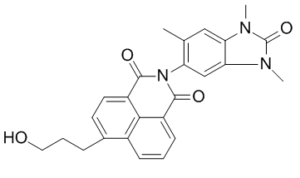BAY-299
This product is for research use only, not for human use. We do not sell to patients.

For small sizes, please check our retail website as below: www.invivochem.com
| Size | Price | Stock |
|---|---|---|
| 250mg | $700 | Check With Us |
| 500mg | $1150 | Check With Us |
| 1g | $1725 | Check With Us |
Cat #: V4187 CAS #: 2080306-23-4 Purity ≥ 98%
Description: BAY-299 (BAY299) is a novel, highly potent, and selective dual inhibitor of BRD1 and TAF1 with important biological activity.
Top Publications Citing Invivochem Products
Publications Citing InvivoChem Products
Product Promise

- Physicochemical and Storage Information
- Protocol
- Related Biological Data
- Stock Solution Preparation
- Quality Control Documentation
| Molecular Weight (MW) | 429.47 |
|---|---|
| Molecular Formula | C25H23N3O4 |
| CAS No. | 2080306-23-4 |
| Storage | -20℃ for 3 years in powder formr |
| -80℃ for 2 years in solvent | |
| SMILES Code | O=C1N(C2=C(C)C=C(N3C)C(N(C)C3=O)=C2)C(C4=CC=C(CCCO)C5=CC=CC1=C45)=O |
| Synonyms | BAY-299; BAY 299; BAY299 |
| Protocol | In Vitro | BAY-299 is a dual inhibitor of the bromodomain and PHD finger (BRPF) family member BRPF2 and the TATA box binding protein-associated factors TAF1 and TAF1L. TR-FRET assays showed that BAY-299 is a potent inhibitor of BRPF2 BD with an IC50 of 67 nM, and a selectivity of 47- and 83-fold over BRPF1 and BRPF3 BDs. The profile of BAY-299 is further confirmed by AlphaScreen assay, where an IC50 of 97 nM and a selectivity of 23- and 25-fold over BRPF1 and BRPF3 BDs are measured. NanoBRET experiments show that the interaction of BRPF2 BD with histones H4 and H3.3 is blocked by BAY-299 with IC50 values of 575 and 825 nM, respectively. For TAF1 BD2, the IC50 values are 970 and 1400 nM, respectively. No inhibitory effect is observed for the interaction between BRPF1 or BRD4 and histone H4 up to 10 μM for BAY-299. BAY-299 inhibits MOLM-13, MV4-11, 769-P, Jurkat, NCI-H526, CHL-1, and 5637 cells proliferation with GI50s of 1060, 2630, 3210, 3900, 6860, 7400, and 7980 nM, respectively. |
|---|---|---|
| In Vivo | Studies of the in vivo pharmacokinetic properties of BAY-299 in rat reveal that blood clearance is low (ca. 17% of hepatic blood flow), volume of distribution in steady-state high, terminal half-life long to very long (t1/2=10 h), and bioavailability high (F=73%). In vivo blood clearance is as anticipated based on rat liver microsome values but lower than expected based on hepatocyte data. |
These protocols are for reference only. InvivoChem does not
independently validate these methods.
| Solvent volume to be added | Mass (the weight of a compound) | |||
|---|---|---|---|---|
| Mother liquor concentration | 1mg | 5mg | 10mg | 20mg |
| 1mM | 2.3285 mL | 11.6423 mL | 23.2845 mL | 46.5690 mL |
| 5mM | 0.4657 mL | 2.3285 mL | 4.6569 mL | 9.3138 mL |
| 10mM | 0.2328 mL | 1.1642 mL | 2.3285 mL | 4.6569 mL |
| 20mM | 0.1164 mL | 0.5821 mL | 1.1642 mL | 2.3285 mL |
The molarity calculator equation
Mass(g) = Concentration(mol/L) × Volume(L) × Molecular Weight(g/mol)
Mass
=
Concentration
×
Volume
×
Molecular Weight*
The dilution calculator equation
Concentration(start)
×
Volume(start)
=
Concentration(final)
×
Volume(final)
This equation is commonly abbreviated as: C1 V1 = C2 V2
Concentration(start)
C1
×
Volume(start)
V1
=
Concentration(final)
C2
×
Volume(final)
V2
Step One: Enter information below
Dosage mg/kg
Average weight of animals g
Dosing volume per animal µL
Number of animals
Step Two: Enter the in vivo formulation
%DMSO
+
%
+
%Tween 80
+
%ddH2O
Calculation Results:
Working concentration:
mg/ml;
Method for preparing DMSO master liquid:
mg
drug pre-dissolved in
µL
DMSO(Master liquid concentration
mg/mL)
,Please contact us first if the concentration exceeds the DMSO solubility of the batch of drug.
Method for preparing in vivo formulation:
Take
µL
DMSO master liquid, next add
µL
PEG300, mix and clarify, next add
µL
Tween 80,mix and clarify, next add
µL
ddH2O,mix and clarify.
Note:
- (1) Please be sure that the solution is clear before the addition of next solvent. Dissolution methods like vortex, ultrasound or warming and heat may be used to aid dissolving.
- (2) Be sure to add the solvent(s) in order.




































